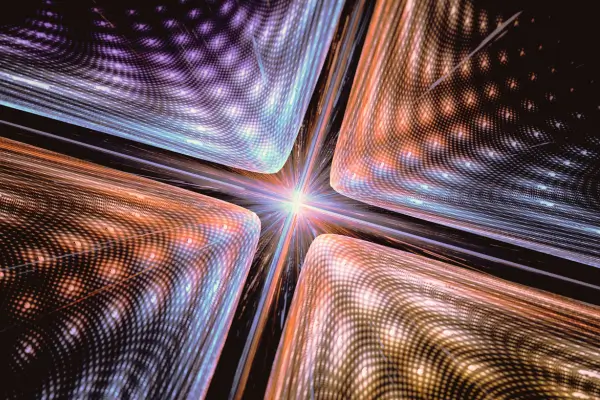The field of quantum materials has seen tremendous growth, especially in quantum computing, photonics, and optoelectronics. Among the most promising materials are doped II-VI nanocrystals, which possess unique electronic and optical properties that are highly sought after for next-generation technologies. These materials are engineered at the atomic scale to control their electrical and optical behaviour, which is crucial for their use in quantum devices.[1]
In this blog, we will explore the deposition methods for fabricating doped II-VI nanocrystals, with a focus on two key techniques: Physical Vapor Deposition (PVD) and Molecular Beam Epitaxy (MBE). We’ll also highlight how these techniques are applied to the synthesis of high-quality nanocrystals with tailored properties for quantum materials.
What are Doped II-VI Nanocrystals?
II-VI semiconductors are a group of compounds made from elements in groups II and VI of the periodic table, such as ZnS, ZnSe, CdTe, and CdSe. Doping these semiconductors with transition metals or rare-earth ions imparts specific properties, including enhanced optical emission or magnetic behavior, making them ideal for quantum applications. [2]
Doped II-VI nanocrystals have been shown to exhibit:
- Quantum confinement effects (when the material is reduced to the nanoscale),
- Size-dependent optical properties, and
- Tailorable energy levels.
These characteristics make them a prime candidate for use in quantum devices such as quantum dots, lasers, light-emitting diodes (LEDs), and solar cells.[3]
Why PVD and MBE for Deposition?
When it comes to synthesizing doped II-VI nanocrystals, two of the most commonly used methods are Physical Vapor Deposition (PVD)[4] and Molecular Beam Epitaxy (MBE)[5]. Both techniques allow for the precise control over material thickness, doping concentration, and atomic arrangement, which are critical for producing high-quality nanocrystals.
Physical Vapor Deposition (PVD)
PVD is a widely used technique for depositing thin films, including doped II-VI nanocrystals, by evaporating material in a vacuum and allowing it to condense on a substrate. The primary advantage of PVD lies in its flexibility and scalability, making it suitable for large-scale production of quantum materials.[6]
How PVD Works:
- Source Material (II-VI compound and dopant) is vaporized by a high-temperature source such as an electron beam, resistive heating, or sputtering.
- The vaporized atoms travel through a vacuum and condense on a substrate, forming a thin film.
- By adjusting the deposition parameters (e.g., temperature, pressure, and substrate orientation), doped II-VI nanocrystals can be precisely controlled for specific optical and electronic properties.
Advantages of PVD for Quantum Materials:
- Control over film thickness and doping concentration.
- High throughput and scalability for industrial production.
- Ability to deposit on a wide range of substrates, including metals, semiconductors, and insulators.
Molecular Beam Epitaxy (MBE)
MBE is a more precise technique that operates under ultra-high vacuum conditions. It involves the deposition of atoms or molecules onto a substrate using a beam of atoms or molecules that are directed toward the surface. MBE offers superior control over the material composition and epitaxial growth of the deposited film, making it ideal for the creation of quantum structures like quantum dots or quantum wells.[7]
How MBE Works:
- Source Materials (II-VI compounds and dopants) are heated in effusion cells to produce atomic beams.
- The atoms or molecules are directed toward a heated substrate, where they condense and grow in a highly controlled manner.
- Atomic layer precision is achieved, which is crucial for creating high-quality nanocrystals with tailored electronic properties.
Advantages of MBE for Quantum Materials:
- Atomic layer control for highly precise doping and epitaxial growth.
- Ability to create heterostructures and quantum wells with exceptional crystalline quality.
- Superior control over doping concentration and defect minimization, both of which are critical for quantum applications.
Challenges and Future Potential for Doping in II-VI Nanocrystals
The incorporation of dopants into II-VI nanocrystals is not without its challenges. Doping must be carefully controlled to avoid defects, aggregation of dopant atoms, or phase separation. Both PVD and MBE offer the precision necessary to tackle these challenges, but the exact methods depend on the specific dopants being used and the desired properties of the nanocrystals.[8]
Common Dopants for II-VI Nanocrystals
- Transition metals like Mn, Co, or Ni for spintronic applications.
- Rare-earth ions like Eu, Tb, or Er for optical and photonics applications.
- Group III elements (e.g., Al, Ga) for altering bandgaps or enabling heterostructure formation.
Applications of Doped II-VI Nanocrystals in Quantum Materials
Doped II-VI nanocrystals have a wide range of applications in quantum materials:
- Quantum Dots (QDs): Used in quantum computing, optical sensing, and biomedical imaging. [9]
- Quantum Lasers: Doped II-VI nanocrystals can be engineered to emit light at specific wavelengths, making them ideal for quantum lasers. [10]
- Solar Cells and LEDs: The unique optical properties of doped nanocrystals make them highly effective in photovoltaic cells and solid-state lighting. [11]
The precise deposition of doped II-VI nanocrystals using PVD or MBE plays a pivotal role in optimizing their performance for these applications, where atomic-level control over material properties is essential.
Conclusion
PVD and MBE are both critical techniques for the fabrication of doped II-VI nanocrystals in the field of quantum materials. These deposition methods offer precision and control over the doping process, leading to the development of nanocrystals with tailored optical and electronic properties that are essential for quantum computing, photonics, and optoelectronics.
As quantum technologies continue to advance, PVD and MBE will remain at the forefront of quantum material fabrication, enabling the next generation of quantum devices and advanced technologies.
Contact us to speak with a technical expert about fabricating doped II-VI nanocrystals for quantum materials using our advanced PVD and MBE deposition systems.
References
- Bayram, C., & Liu, R. (2017). Exploring the next phase in gallium nitride photonics: Cubic phase light emitters heterointegrated on silicon. In Semiconductors and Semimetals (Vol. 96, pp. 411-435). Elsevier. https://doi.org/10.1016/bs.semsem.2016.07.001
- Krishnan, B., Shaji, S., Acosta-Enriquez, M., Acosta-Enriquez, E., Ortega, R., Zayas, M., Castillo, S., Palamà, I., D’Amone, E., Pech-Canul, M. I., D’Amone, S., & Cortese, B. (2019). Group II–VI semiconductors. In Semiconductors: Properties, Technologies, and Applications (pp. 397-464). Springer. https://doi.org/10.1007/978-3-030-02171-9_7
- Drozdick, H. K., Weiss, R., Sullivan, C. M., Wieghold, S., & Nienhaus, L. (2022). Widespread opportunities for materials engineering of nanocrystals: Synthetically tailorable effects and methodologies. Matter, 5(6), 1645-1669. https://doi.org/10.1016/j.matt.2022.04.023
- Mocatta, D., Cohen, G., Schattner, J., Millo, O., Rabani, E., & Banin, U. (2011). Heavily doped semiconductor nanocrystal quantum dots. Science, 332(6025), 77-81. https://doi.org/10.1126/science.1196321
- Sou, I. K., Lok, S. K., Wang, G., Wang, N., & Wong, G. K. L. (2010). MBE-grown II-VI and related nanostructures. Journal of Electronic Materials, 39(7), 882-892. https://doi.org/10.1007/s11664-010-1215-3
- Mattox, D. M. (2010). Vacuum evaporation and vacuum deposition. In Handbook of physical vapor deposition (PVD) processing (2nd ed., pp. 195-235). Elsevier. https://doi.org/10.1016/B978-0-8155-2037-5.00006-X
- Irvine, S. J. C. (2024). Film growth and epitaxy methods. In Encyclopedia of condensed matter physics (2nd ed., Vol. 5, pp. 248-260). Elsevier. https://doi.org/10.1016/B978-0-323-90800-9.00210-9
- Yang, H., Santra, S., & Holloway, P. (2005). Syntheses and applications of Mn-doped II-VI semiconductor nanocrystals. Journal of Nanoscience and Nanotechnology, 5(10), 1364-1375. https://doi.org/10.1166/jnn.2005.308
- Malik, P., Thareja, R., Singh, J., & Kakkar, R. (2022). II-VI core/shell quantum dots and doping with transition metal ions as a means of tuning the magnetoelectronic properties of CdS/ZnS core/shell QDs: A DFT study. Journal of Molecular Graphics and Modelling, 111, 108099. https://doi.org/10.1016/j.jmgm.2021.108099
- Mimona, M. A., Rimon, M. I. H., Zohura, F. T., Sony, J. M., Rim, S. I., Arup, M. M. R., & Mobarak, M. H. (2025). Quantum dot nanomaterials: Empowering advances in optoelectronic devices. Chemical Engineering Journal Advances, 21, 100704. https://doi.org/10.1016/j.ceja.2025.100704
- Huy, B. T., Kwon, D. H., Lee, S.-S., Dao, V.-D., Truong, H. B., & Lee, Y.-I. (2022). Optical properties of Sr₂YF₇ material doped with Yb³⁺, Er³⁺, and Eu³⁺ ions for solar cell application. Journal of Alloys and Compounds, 897, 163189. https://doi.org/10.1016/j.jallcom.2021.163189


